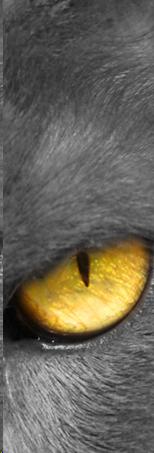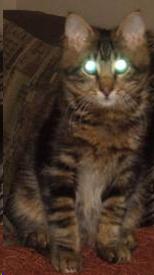
The Cat's Vision


Unlike human eyes which work best in daylight, the cat's eyes are specialized to function extremely well under conditions of dim light, again reflecting its historical role as a nocturnal predator. Cat eyes are able to function in approximately 1/6th the amount of the light needed for human vision. But they must also be able to function well in daylight, and one adaptation of the cat's eye that allows this is the pupil which can open very widely in low light levels, but can also contract to a very small size in bright light. While in humans this process is controlled by a circular ciliary muscle, in cats there are two ciliary muscles that give the cat its characteristic elliptical pupil that becomes slit-like in bright light conditions.
The cat eye also has a layer of specialized reflective cells called the tapetum lucidum located behind the retina. These cells reflect unabsorbed light back toward the retina, thus providing a second opportunity for light absorption. Together these adaptations allow the cat to see well in low illumination.
But it's important to emphasize that cats do need some illumination to see. They cannot see in total darkness, which is a common misconception.
Cats are also said to be colorblind, but under bright light they are capable of detecting some color, usually only faint hues or a washed out version of what we see. This is believed to be due to the fact that it's more important for predators to detect movement than to see the colors of vegetation.